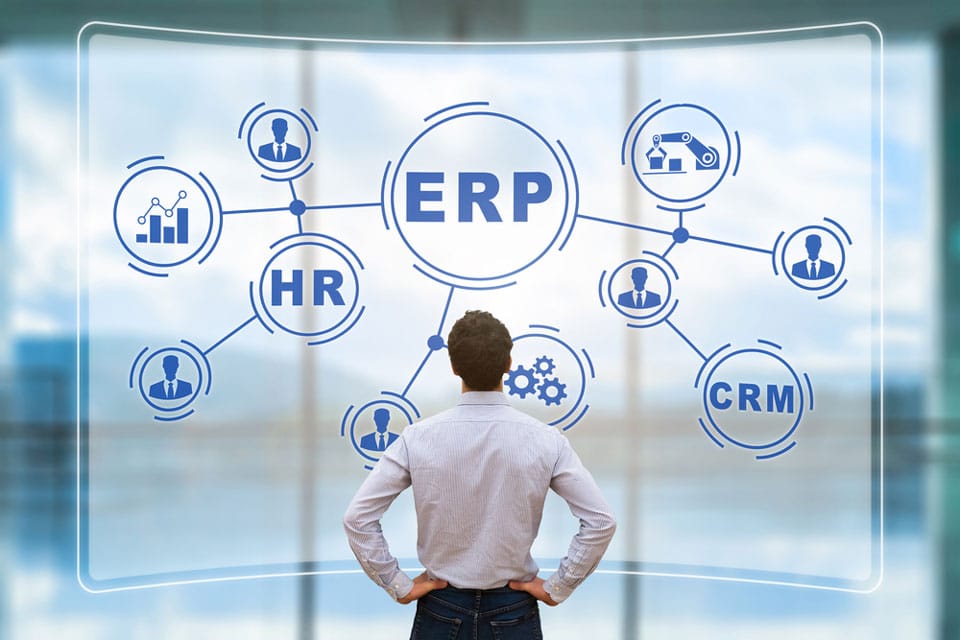Streamline Your Operations: The Key Points Of ERP Systems

Are you a business owner looking for a way to streamline your operations? Do you need an efficient and reliable system to manage your finances, inventory, customer relations, and more? If so, then ERP systems are the perfect solution.
What is an ERP System?
An enterprise resource planning (ERP) system is a suite of integrated software applications that enables businesses to manage key aspects of their operations, including accounting, manufacturing, supply chain, human resources, customer relationship management (CRM), and other core business processes. ERP systems are designed to provide organizations with a unified view of their data and the ability to quickly access and analyze it. ERP systems are typically made up of a number of modules that all work together to provide the necessary functionality for a business. Common ERP modules include financial accounting, purchasing, inventory control, sales order management, project management, and others. ERP systems are generally deployed on-premise or in the cloud. Regardless of the deployment method, ERP systems provide businesses with a single source of truth for their data and give them the tools they need to make informed decisions about their operations.
Benefits of Implementing an ERP System
Implementing an enterprise resource planning (ERP) system in your business can bring a wide range of benefits. From streamlining processes and improving operational efficiency to providing deeper visibility into data and enhancing security, here are some of the key advantages you can gain from an ERP:
Enhanced Operational Efficiency: ERP systems automate and optimize core business processes, enabling you to reduce costs and save time. This reduces the need for manual labor and frees up resources that can be used elsewhere in your organization.
Better Decision-Making: ERP systems provide greater visibility into key performance indicators (KPIs) that can help you make more informed decisions. With real-time insights into your operations, you can quickly identify areas where improvements can be made.
Improved Security & Compliance: ERP systems enhance security by providing deeper visibility into data and increased control over access. This ensures that only authorized personnel can access sensitive information and helps you to meet industry regulations.
Leverage AI, Machine Learning & Analytics: ERP systems can be integrated with AI, machine learning and analytics tools to gain further insights into operations and improve performance. This allows you to identify opportunities for improvement, optimize processes and drive better results.
Key Components of an ERP System
An ERP system is composed of several components that work together to help organizations streamline operations, boost efficiency, and improve decision-making. The key components of an ERP system include:
- Enterprise resource planning software: This is the core component of an ERP system. It is a cloud-based or on-premise system used to manage all aspects of a business from financials to operations and customer relations.
- Business intelligence & analytics: This component helps organizations extract and analyze data from the ERP system in order to gain insights for better decision-making.
- Automated workflow & process management: This component helps organizations streamline processes, monitor compliance, and automate tasks.
- Reporting & dashboards: This component provides real-time visibility into business performance across multiple departments and functions.
- Mobile access: This component allows users to access the ERP system anytime, anywhere, on any device.
- Security & compliance management: This component helps organizations ensure their data is secure and compliant with industry standards.
Types of ERP Systems for Different Businesses
When it comes to the types of ERP systems, there are a variety of solutions that can be tailored to the specific needs of businesses. While some solutions are industry-specific, such as those designed for manufacturing or retail, many ERP solutions can be customized for any business. As such, any business can choose from a range of ERP systems to find one that best fits their needs.
For large enterprises, there are ERP systems that offer extensive functionality and scalability for growing businesses. These solutions may include fully integrated modules for finance, supply chain management, customer relationship management, and more. Additionally, these enterprise solutions often provide industry-specific capabilities for specific industries such as retail or manufacturing.
For small and midsize businesses, there are ERP systems that are designed to be easily implemented and managed in-house. These solutions are typically cloud-based and offer features such as project management, invoicing, inventory tracking, and more. Additionally, they often include built-in analytics and reporting capabilities so businesses can track key performance indicators (KPIs).
For businesses with specific needs—such as those in the healthcare industry—there are specialized ERP systems that provide comprehensive functionality that meets the unique requirements of the industry. These solutions typically include features such as patient record management, medical billing and coding, and more.
Cloud vs On-Premise ERPs
When it comes to ERP systems, the two main options are cloud-based and on-premise. Cloud-based ERP systems use cloud computing technology to store and process data in the cloud. This type of system is typically easier to set up and maintain, and tends to be less expensive as there is no need to purchase hardware or pay for additional IT support. On-premise ERP systems, on the other hand, require physical hardware and software to be installed and maintained onsite, making it a more complex solution. The upside is that the company has complete control over their data and the system can be tailored to their specific needs.
Businesses must weigh up their options when selecting an ERP system, considering factors such as budget, scalability, security, and performance. Cloud-based ERPs are well suited for companies with limited budgets that require quick implementation and rapid scalability, while on-premise systems offer greater control over data and better performance. Ultimately it depends on the size of the organization, their business goals, and the complexity of their processes.
Choosing the Right ERP Solution for Your Business
When it comes to choosing the right ERP system for your business, there are a few key factors to consider. First, consider the size and scope of your business. Enterprise resource planning systems come in all shapes and sizes, so you’ll want to make sure you have an ERP that’s tailored to your specific needs. It’s also important to think about the functionality you need from an ERP system. Some systems offer more extensive features, while others focus on specific tasks such as financial management or inventory control.
It’s also important to consider the scalability of the system. If you plan on expanding your business in the future, you’ll want an ERP system that can grow with you. Finally, look into the cost of implementation and maintenance. Make sure you understand the full cost of ownership before making a decision. It’s also a good idea to talk to other businesses that have successfully implemented ERP systems to get their input on the process.
Challenges to Overcome When Implementing an ERP System
Implementing an ERP system can be a complex and challenging task. It requires a significant amount of time and resources, as well as thorough planning to ensure a successful deployment. Some of the primary challenges to consider when implementing an ERP system include developing a comprehensive understanding of the business’s current state and objectives, integrating existing systems and processes, training users, and ensuring data accuracy and consistency. Additionally, organizations must be prepared to address any unforeseen issues that arise along the way. To ensure a successful implementation, it’s important to have a clear plan in place that outlines the steps that need to be taken, as well as dedicated resources to handle any potential issues.
Cost Considerations for Implementing an ERP System
When considering the cost of implementing an ERP system, it is important to factor in the costs of licenses and software. In addition, there are additional costs associated with customizing the software to meet the specific needs of your business, as well as the cost of training staff to use the system. There are also ongoing costs associated with maintenance, upgrades and support services. Additionally, you may need to consider subscription fees for cloud-based ERP solutions. It is important to make sure that the ERP solution you choose is cost-effective and provides value for money. In order to get a better idea of the total cost of ownership, consider calculating the return on investment (ROI) for your ERP solution.
How to Prepare for a Successful Implementation
When it comes to implementing an ERP system, proper preparation is key. To ensure a successful deployment, it’s important to take the time to understand the organization’s current business processes, analyze their needs and expectations, and plan the implementation accordingly. Here are a few tips to help you prepare for a successful ERP implementation:
- Establish Goals & Objectives: It’s important to establish clear goals and objectives before beginning the implementation process. This will help keep the project on schedule and ensure it is completed within the desired timeframe.
- Assign a Project Manager: A project manager should be assigned to oversee the implementation process and ensure that it runs smoothly. The project manager should have experience in successfully deploying ERP systems and should be able to coordinate the efforts of all involved parties.
- Gather Requirements: Gather requirements from all stakeholders to ensure the system meets their needs. This will also help identify any potential issues or conflicts that may arise during the implementation process.
- Select an ERP System: Select an ERP system that meets all of the organization’s requirements and that can be integrated easily with existing systems.
- Test & Validate: Before deploying the ERP system, it’s important to test and validate all components to ensure that they work as expected. This will help minimize downtime when transitioning from one system to another.
- Train Employees: Employees have to be trained appropriately so the business maximizes its profit.
Best Practices for Planning and Executing a Successful Deployment
When implementing an ERP system, it is important to have a plan and execute it properly. Best practices for planning and executing a successful deployment include:
- Start with a clear goal: Before beginning the implementation process, it is essential to have a well-defined goal in mind. This goal should be measurable and achievable. It should also align with the company’s overall strategy and objectives.
- Assign ownership: Assign clear ownership of the ERP project to an individual or team who will be responsible for ensuring the successful deployment.
- Gather all stakeholders: Ensure that all stakeholders are involved in the process. This includes senior management, IT personnel, accounting teams, HR teams, and any other departments that may be affected by the implementation.
- Conduct a thorough analysis: Analyze the current processes and identify areas for improvement. This will ensure that the new ERP system will be able to address existing issues and meet current needs.
- Develop a timeline: Establish a timeline for the implementation process and ensure that all parties understand their roles and responsibilities throughout the process.
- Test before launch: Prior to launching the new system, it is essential to thoroughly test it to ensure that it is functioning correctly and meets the needs of all stakeholders.
- Monitor performance: Once the system is launched, it is important to monitor its performance regularly to ensure that it is meeting expectations and delivering desired results.
Continuous Improvement with Automated Updates
The implementation of an ERP system should not stop once the system has been set up and deployed. To ensure that a company is equipped to handle any changes in the business environment, it is important to continuously monitor and update the system. Automated updates are essential for providing up-to-date features and ensuring that the system is running at its optimal performance. By taking advantage of automated updates, businesses can ensure that the ERP system is always up-to-date with the latest technology and features, giving them an edge over their competition. Automated updates also help to reduce time and cost associated with manual updating processes, as well as minimize data loss and downtime associated with manual updates. Automated updates can also provide enhanced security measures, allowing businesses to stay ahead of any potential threats or vulnerabilities.
Enhancing Security and Compliance with Deeper Visibility into Data
To ensure the security and compliance of their ERP systems, businesses need to have deeper visibility into the data stored within the system. This can be accomplished by using advanced security measures such as encryption, multi-factor authentication, data masking, and role-based access control. With these measures in place, businesses can rest assured that their sensitive data is protected from unauthorized access. Furthermore, ERP systems can be configured to detect any suspicious activity or anomalies in the system and alert authorized personnel immediately. This helps to ensure that any malicious activity is quickly identified and addressed before it can cause any damage. By having deeper visibility into the data stored in their ERP systems, businesses can be confident that they are meeting all of the necessary requirements for compliance and security.
Leveraging AI, Machine Learning, and Analytics to Optimize Performance
In the modern business environment, organizations of all sizes are leveraging the power of AI, machine learning, and analytics to optimize their ERP performance. With AI and machine learning, businesses can automate processes across their ERP system to improve accuracy and efficiency. Advanced analytics can help identify areas of improvement and reveal potential opportunities for increased performance. AI can be used to uncover insights from data that would otherwise be too difficult or costly to extract manually. Automated machine learning algorithms can quickly adapt to changing market conditions, making sure your business stays ahead of the competition. Additionally, analytics can provide deeper visibility into key metrics within your ERP system, enabling you to make more informed decisions. With these powerful technologies, you can maximize the potential of your ERP system and ensure your business is running optimally.
In conclusion, ERP systems are essential for businesses to effectively manage their data and processes. ERP systems provide organizations with a unified view of their operations, helping them to become more efficient and productive. They also enable businesses to leverage powerful tools such as AI, machine learning, and analytics to optimize performance and gain deeper visibility into their data. Implementing an ERP system is not without its challenges, however, but with careful planning and execution, businesses can reap the rewards of having a powerful and effective system in place.
Written by Vangelis Kotselas.
Have you read?
Which are the healthiest countries in the world for 2023?
Best Business Schools In The World For 2023.
CEO Spotlight: Harmony Vallejo – CEO of Universal Events Inc.
How Big Companies Can Innovate Like Small Start-ups by Vikas Chadha.
Essential leadership traits to build organizations of the future by Kamales Lardi.
Planning for 2023: Four Things Business Owners Should Know For The Year Ahead by Jacob Wolinsky.
Add CEOWORLD magazine to your Google News feed.
Follow CEOWORLD magazine headlines on: Google News, LinkedIn, Twitter, and Facebook.
Copyright 2024 The CEOWORLD magazine. All rights reserved. This material (and any extract from it) must not be copied, redistributed or placed on any website, without CEOWORLD magazine' prior written consent. For media queries, please contact: info@ceoworld.biz









